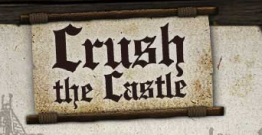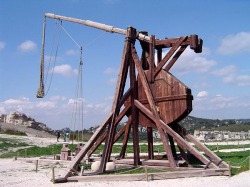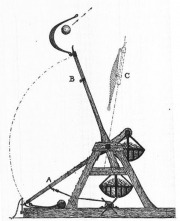Beastly Ancient Weapons
The Castle Crusher: The Trebuchet
The Trebuchet, or Trebucket, was a terrifying weapon developed by ancient civilizations, but finalized by the Duke of Normandy, Richard the Lionheart, in late June 1191. He concentrated on creating a weapon that would crush castle walls or chuck objects over them. This horrifying siege weapon is much more simple than it looks, it's basically a lever and a sling! Info adapted from http://www.trebuchet.com/
How It Works
The trebutchet begins with a bucket with weight at one end of the arm. On the other end, a sling holds a projectile like a stone or (if you like Lord Of The Rings) corpses to throw at the enemy. The bucket is filled with a heavy object or objects, such as rocks or sand. The sling is wired to the base with a piece of rope. With the sling loaded, the rope is cut, releasing the counterweight in the bucket. The counterweight falls earthward and pulls the sling with it. At a certain point in the air, the projectile leaves the sling, flying toward the helpless knights and castle walls. But how does this concern physics?
The Physics Behind the Weapon

The Trebuchet works in a simple way, but even with the technology today it can be hard to get one to work right. A writer named Nicholas on Physicsforums.com described a trebuchet's physics pretty well.
"The trebuchet uses moment arms to increase the acceleration caused by the falling CW. The energy is transfered to the projectile (which is much lighter) by use of the main arm and a sling. While the main arm (a) is longer than the counterweight arm (b) to increase the rotational velocity. In addition, the sling provides another radius (c) which further boosts the velocity of the projectile." says Nicholas. A geocities also explains the physics in an easy to understand way; "Once the arm (total arm length = a+b) has extended beyond its release point, the slip ring attached to the sling can no longer hold on to the release pin. This causes the sling to open and extended, hurling the ammunition."
"To optimize its release velocity one must optimize the ratio between a, b, and c. The ratio between a and b determine how much faster the tip of the main arm rotates in relation to the counterweight arm (b). C determines how long the CW can free fall before having to accelerate the projectile. It is also another radius which changes the velocity."
"Furthermore, the total acceleration time is determined by the distance CW can fall before it reaches its apex. Since the CW is free to rotate, assume it follows a completely straight path untill release.
Keep in mind that this device is gravity powered. If the ratio between a is not long enough compared to b, it won't achieve peak velocity, whereas if it is too long, it will apply more torque than the CW, causing a misfire."
This is how Nicholas explains the Trebuchet. Still too complicated? YOU try it! Click on Crush the Castle Pic above and try the game yourself! Good luck!
"The trebuchet uses moment arms to increase the acceleration caused by the falling CW. The energy is transfered to the projectile (which is much lighter) by use of the main arm and a sling. While the main arm (a) is longer than the counterweight arm (b) to increase the rotational velocity. In addition, the sling provides another radius (c) which further boosts the velocity of the projectile." says Nicholas. A geocities also explains the physics in an easy to understand way; "Once the arm (total arm length = a+b) has extended beyond its release point, the slip ring attached to the sling can no longer hold on to the release pin. This causes the sling to open and extended, hurling the ammunition."
"To optimize its release velocity one must optimize the ratio between a, b, and c. The ratio between a and b determine how much faster the tip of the main arm rotates in relation to the counterweight arm (b). C determines how long the CW can free fall before having to accelerate the projectile. It is also another radius which changes the velocity."
"Furthermore, the total acceleration time is determined by the distance CW can fall before it reaches its apex. Since the CW is free to rotate, assume it follows a completely straight path untill release.
Keep in mind that this device is gravity powered. If the ratio between a is not long enough compared to b, it won't achieve peak velocity, whereas if it is too long, it will apply more torque than the CW, causing a misfire."
This is how Nicholas explains the Trebuchet. Still too complicated? YOU try it! Click on Crush the Castle Pic above and try the game yourself! Good luck!
The Physics of the Projectile:
Well, we know how a trebuchet works, but how do we know about the projectile itself? How far it goes? It's velocity? http://library.thinkquest.org/05aug/00627/phy.html describes the equations in mathmatical and physics terms.
" We have an object being thrown and want to know it's velocity (speed/distance in relation to time)
We can determine the velocity using a rate of g m/s per second.
This is called the acceleration of gravity. It uses absolute value for gravity (32.2 ft/s2 ).
Let's understand the abbreviations: velocity = v, gravity =g and seconds(time) =t the falling body is dropped.
We can determine distance:
Given the velocity formula , with the integration results in:
where x is the distance an object falls over a time t.
For example, an object falling for 3 seconds would travel 32 x 3 x 3 / 2 = 144 feet
Next, we can think about the velocity with respect to time-
If all of this would be graphed, you would get a parabola! Opening downwards, of course!
If a body is projected upwards with an initial velocity v, then at some time t = v/g, it comes to rest and then begins to fall back. The motion is described by y = vt - gt2/2 at any time, so if this time is substituted, the height of the turning point is found to be y = v2/2g. By a proper choice of the three constants in the general quadratic y = at2 + bt + c, motions under gravity (or any constant acceleration) in one dimension with arbitrary initial position, velocity and time can be described.
So- Get your axes x horizontal and y vertical (going up!)
x=gt^2/2 and y=^2/2g ."
A little complicated? Yeah, we think so too. But, it fully describes how you'd find what you'd want to know. That's all you need to know! The Trebuchet is now in your arsenal, go check out the others!
" We have an object being thrown and want to know it's velocity (speed/distance in relation to time)
We can determine the velocity using a rate of g m/s per second.
This is called the acceleration of gravity. It uses absolute value for gravity (32.2 ft/s2 ).
Let's understand the abbreviations: velocity = v, gravity =g and seconds(time) =t the falling body is dropped.
We can determine distance:
Given the velocity formula , with the integration results in:
where x is the distance an object falls over a time t.
For example, an object falling for 3 seconds would travel 32 x 3 x 3 / 2 = 144 feet
Next, we can think about the velocity with respect to time-
If all of this would be graphed, you would get a parabola! Opening downwards, of course!
If a body is projected upwards with an initial velocity v, then at some time t = v/g, it comes to rest and then begins to fall back. The motion is described by y = vt - gt2/2 at any time, so if this time is substituted, the height of the turning point is found to be y = v2/2g. By a proper choice of the three constants in the general quadratic y = at2 + bt + c, motions under gravity (or any constant acceleration) in one dimension with arbitrary initial position, velocity and time can be described.
So- Get your axes x horizontal and y vertical (going up!)
x=gt^2/2 and y=^2/2g ."
A little complicated? Yeah, we think so too. But, it fully describes how you'd find what you'd want to know. That's all you need to know! The Trebuchet is now in your arsenal, go check out the others!


